
Jodhpur – Land of Sand and Sand Dunes
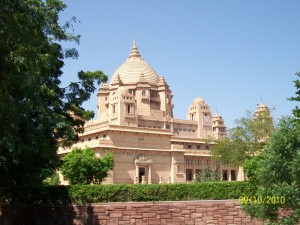 Jodhpur – Land of Sand and Sand Dunes
Jodhpur – Land of Sand and Sand Dunes
For a long time now, I had been planning to ride across the deserts and over the sand dunes in Rajasthan, atop our one humped camels.
I narrowed down my search to two places – Jaisalmer and Jodhpur.
I finally zeroed in on Jodhpur for the simple reason it has one of the finest forts in India, the most modern palace in the country and….. it is easier to travel to Jodhpur from Mumbai or Delhi.
The early capital of the Jodhpur area was not the present city of Jodhpur but Mandore (originally known as Mandavyapur) – 9 kms north of Jodhpur.
Mandore has a long history. During the Ramayana era, Princess Mandodri of Mandavyapur married King Ravana.
During the Gupta period 6th – 7th century AD, Mandore was the ancient capital of the Parihar kings and remained the capital under various kings till the 14th century.
When Kannauj was sacked by Mahmud of Ghazni in 1019, the Gahadvala dynasty gained control of Kannauj and ruled for almost a century. Their best known and last king was Raja Jaichand.
Raja Jaichand’s successors, who came to be known as Rathores, gradually spread across Marwar, forming a loose brotherhood of land owners and village chieftains, bound to each other by clan and caste.
In 1395 AD, Chundaji Rathore married a Parihar princess Mohil and began ruling Mandore.
Rao Jodha, a Rathore chief, conquered the surrounding areas and founded the Marwar state – the largest Rajasthan state during the pre independence days. A 10 km long wall with 8 Gates leading out of it encircled the old city.
Rao Jodha founded the present Jodhpur in 1459 A.D. and shifted his capital from Mandore to Jodhpur.
Mandore (9 Kms) – the Old City 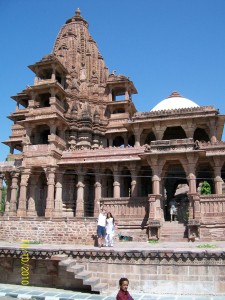
Today, Mandore has a beautiful garden on the slopes of a hill housing a unique collection of royal devals or cenotaphs (cenotaph means a monument erected in honor of a dead person whose remains lie elsewhere or could not be recovered).
Unlike the usual chhatri (umbrella) shaped cenotaphs typical of other places of Rajasthan, the cenotaphs in Mandore are in the shape of beautiful, ornate, Hindu temples.
All the cenotaphs were constructed out of dark red sandstone.
The most impressive one is the four-storey cenotaph of Maharaja Ajit Singh (reigned 1678-1724), with fine columns and an elegant spire.
The garden has a hall of heroes with 16 figures of popular Hindu and folk deities carved out of a single rock, dating back to the 17th – 18th century.
Adjacent to this is a larger hall called “The Shrine of the Three Hundred Million” deities filled with brightly coloured images of various Hindu Gods.
As you climb up the hill, you come to the ruins of old Mandore with its old palace. Set on a rocky outcrop, a ten-minute walk over the hills, are the beautiful cenotaphs of the beautiful Maharanis.
The Mandore museum has a good collection of memoralia.
Modern Jodhpur
Maharaja Rao Jodha founded Jodhpur in 1459 A.D. The same year, he started constructed of the Mehrangarh Fort.
Construction of the Fort was completed by Maharaja Jaswant Singh (1638-1680).
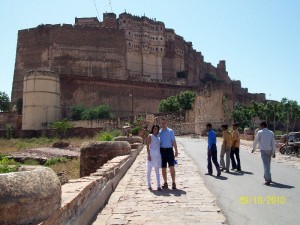
Jodhpur is known as the Sun City for its year round bright, sunny, weather.
It is also known as the Blue City (Jaipur is known as the Pink City), due to the excessive indigo used in white-washing the houses around the Mehrangarh Fort.
Initially, only Brahmins white washed their houses indigo blue. The non-Brahmins soon joined in, as the blue colour (probably it was the indigo) was believed to deflect the heat and keep mosquitoes away.
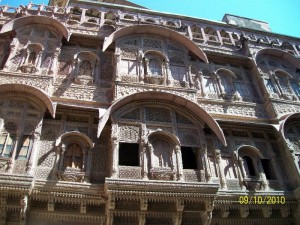
Today Jodhpur has two sectors – the old city and the new city.
The old city is surrounded by a thick stone wall with six huge gates – Nagauri Gate, Merati Gate, Sojati Gate, Jalori Gate, Siwanchi Gate and Chand Pol.
The Old market
After checking in at the hotel, I spent the first evening walking around the Clock Tower and the area around it.
This gave us a taste of the old markets in the old city.
Speaking of taste, you can purchase Jodhpur’s famous red chilli powder around here. Besides, there are lots of shops around selling local handicrafts, lac work and pretty bangles.
Mehrangarh Fort 
The most imposing structure in Jodhpur, and the finest fort in India, is the Mehrangarh Fort. Sprawling over 5 sq. Kms,, the Fort has seven gates.
Built of red sandstone, the Mehrangarh Fort rises sharply on an almost vertical cliff.
The main entrance to the fort is Jai Pol which was built in 1806 by Maharaja Man Singh to commemorate his victory in a battle.
Even though seventeen generations of Rathore rulers have added a number of temples, palaces and courtyards, surprisingly, the overall look is one of symmetry.
Inside the fort are various ornate and decorative structures constructed by different kings – the Phool Mahal, Takhat Mahal, Moti Mahal and Jhanki Mahal.
The bastioned walls with a sprinkling of old cannons on top have been hewn out of rocks and at some places are 24 metres thick and 40 metres high.
The museum inside the Fort has a wonderful collection of palanquins, howdahs, royal cradles, miniatures, musical instruments, costumes and furniture.
And it was here in this Fort, we first met the Flying Fox. The Flying Fox is not an animal. It is an outfit offering India’s first zip line tours or Ziplining (though I prefer to use the shorter word Zipling which I have coined).
Zipling is the sport of soaring high above the ground with your body strapped to a harness which is attached to a zip line which is an aerial runway created by tying a cable between two fixed points usually passing over scenic areas such as jungles, ravines, forests, meadows, sea and lakes.
The zip line is sloped so as to allow the rider to gradually glide down the length of the cable.
The zip lines at Mehrangarh Fort have cables suspended 30 to 200 feet above the ground passing over 6 different stages over the hills, forts and lakes.
The tour does appear a little nightmarish. But its perfectly safe and exhilerating.
Vultures at the Fort
I saw a large number of Vultures flying over the Fort. The locals clarified that this was one of the rare places in India where vultures regularly nest and breed.
Umaid Bhawan Palace
In sharp contrast to the medieval Mehrangarh Fort is the Umaid Bhavan Palace, the latest palace of India.
Built of creamy-pink sandstone and marble, this palace is one of the largest private residences in the world.
It has 374 rooms including eight dining halls, two theatres, a ballroom, ornate reception halls and a huge underground swimming pool.
This palace was built by Maharaja Umaid Singh as a relief project to help his famine-stricken subjects. It took 15 years and 3,000 men to complete this architectural marvel.
The major portion of the palace has been converted into a 5-star heritage hotel. The present Mahrajah Gaj Singh (grandson of Umaid Singh) lives in a segregated portion of the palace. Another portion of the palace houses the museum which is open to tourists.
The museum has a rich collection of decorated weapons, paintings, porcelain, watches, antique clocks and French furniture.
Osian (65km from Jodhpur)
This unique temple town was located on a very important trade route between the 8th and the 12th centuries and contains 16 Hindu and Jain temples of exquisite quality built during that period.
But we went to Osian also to ride over the sand dunes on camel back.
Jaisalmer is more famous for its sand dunes (Sam Sand Dunes), but the sand dunes here are equally fascinating.
 Other Places to see
Other Places to see
Jaswant Thada is a white marble cenotaph with beautiful lattice carvings and pillars built in memory of Maharaja Jaswant II in 1899. It also contains cenotaphs of subsequent rulers and members of the royal family.
You should also visit Balsamand Lake and Gardens; Kailana Lake and Sardar Samand Lake.
Local delicacies
You can taste the local cuisine including shahi samosa, mirchi vada, makhan lassi and the famous Mawa Kachori dipped in sugar syrup.
Conclusion
Jodhpur is an important city.
The High Court of Rajasthan is located here.
And it is well connected to the major cities of India, by air, rail and road.
A number of Heritage hotels of all varieties are coming up.
Jodhpur is famous for its feisty festivals, folk songs, hospitality and great food.
You can watch a lot of festivities during the month of October.
You can take a safari tour which will give you a glimpse of the lifestyle and craft of the potters and weavers, and you can also have a meal with them.
Incidentally, this is the home of the famous Bishnoi community where the black buck and other wild animals are savagely protected and it was here Salman Khan was caught and charged for wild life poaching.

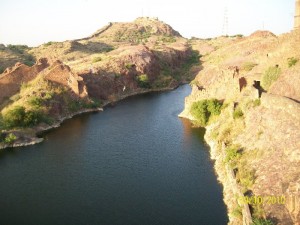
There was some problem in posting this article.
I will make the necessary corrections and
formatting.
Pingback:Los Angeles Precast
Kein Kontakt auf dem Jahnplatz heute, wahrscheinlich war mein letzter Kommentar zu kurzfristig. Vielleicht beim nächsten Mal? Wenn man will, kann man Kontaktdaten für eine Verabredung finden. (Übrigens, Christian, dein Spiel mit dem Namen Humboldt habe ich nicht verstanden.)